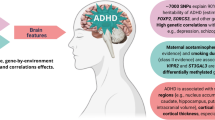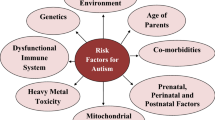Abstract
Evidence suggests over-representation of autism spectrum disorders (ASDs) and behavioral difficulties among people referred for gender issues, but rates of the wish to be the other gender (gender variance) among different neurodevelopmental disorders are unknown. This chart review study explored rates of gender variance as reported by parents on the Child Behavior Checklist (CBCL) in children with different neurodevelopmental disorders: ASD (N = 147, 24 females and 123 males), attention deficit hyperactivity disorder (ADHD; N = 126, 38 females and 88 males), or a medical neurodevelopmental disorder (N = 116, 57 females and 59 males), were compared with two non-referred groups [control sample (N = 165, 61 females and 104 males) and non-referred participants in the CBCL standardization sample (N = 1,605, 754 females and 851 males)]. Significantly greater proportions of participants with ASD (5.4 %) or ADHD (4.8 %) had parent reported gender variance than in the combined medical group (1.7 %) or non-referred comparison groups (0–0.7 %). As compared to non-referred comparisons, participants with ASD were 7.59 times more likely to express gender variance; participants with ADHD were 6.64 times more likely to express gender variance. The medical neurodevelopmental disorder group did not differ from non-referred samples in likelihood to express gender variance. Gender variance was related to elevated emotional symptoms in ADHD, but not in ASD. After accounting for sex ratio differences between the neurodevelopmental disorder and non-referred comparison groups, gender variance occurred equally in females and males.

Similar content being viewed by others
References
Achenbach, T. M., & Rescorla, L. A. (2001). Manual for ASEBA School-Age Forms & Profiles. Burlington, VT: University of Vermont, Research Center for Children, Youth, & Families.
American Psychiatric Association. (2000). Diagnostic and statistical manual of mental disorders (4th ed., text rev.). Washington, DC: Author.
American Psychiatric Association. (2013). Diagnostic and statistical manual of mental disorders (5th ed.). Arlington, VA: Author.
Arnold, S. D. (1996). Sex differences in ADHD: Conference summary. Journal of Abnormal Child Psychology, 24, 555–569.
Baird, G., Simonoff, E., Pickles, A., Chandler, S., Loucas, T., Meldrum, D., et al. (2006). Prevalence of disorders of the autism spectrum in a population cohort of children in South Thames: The Special Needs and Autism Project (SNAP). Lancet, 368, 210–215.
Baron-Cohen, S. (2002). The extreme male brain theory of autism. Trends in Cognitive Sciences, 6, 248–254.
Baron-Cohen, S. (2009). Autism: The empathizing-systemizing (E-S) theory. Annals of the New York Academy of Sciences, 1156, 68–80.
Beacher, F. D. C. C., Radulescu, E., Minati, L., Baron-Cohen, S., Lombardo, M. V., Lai, M., et al. (2012). Sex differences and autism: Brain function during verbal fluency and mental rotation. PLoS ONE, 7. doi:10.1371/journal.pone.0038355.
Bedard, C., Zhang, H. L., & Zucker, K. J. (2010). Gender identity and sexual orientation in people with developmental disabilities. Sexuality and Disability, 28, 165–175.
Bejerot, S., Eriksson, J. M., Bonde, S., Carlström, K., Humble, M. B., & Eriksson, E. (2012). The extreme male brain revisited: Gender coherence in adults with autism spectrum disorder. British Journal of Psychiatry, 201, 116–123.
Biddle, D. A., & Morris, S. B. (2011). Using Lancaster’s mid-P correction to the Fisher’s exact test for adverse impact analyses. Journal of Applied Psychology, 96, 956–965.
Bland, J. M., & Altman, D. G. (2000). Statistics notes: The odds ratio. British Medical Journal, 320, 1468.
Center for Disease Control and Prevention. (2012). Prevalence of autism spectrum disorders—autism and developmental disabilities monitoring network, fourteen sites, United States, 2008. Surveillance Summaries, 61, 1–19.
Coates, S., & Person, E. S. (1985). Extreme boyhood femininity: Isolated behavior or pervasive disorder? Journal of the American Academy of Child Psychiatry, 24, 702–709.
Cohen-Kettenis, P. T., Owen, A., Kaijser, V. G., Bradley, S. J., & Zucker, K. J. (2003). Demographic characteristics, social competence, and behavior problems in children with gender identity disorder: A cross-national, cross-clinic comparative analysis. Journal of Abnormal Child Psychology, 31, 41–53.
Constantino, J. N., & Gruber, C. P. (2005). Social Responsiveness Scale. Los Angeles, CA: Western Psychological Services.
de Vries, A. L. C., & Cohen-Kettenis, P. T. (2012). Clinical management of gender dysphoria in children and adolescents: The Dutch approach. Journal of Homosexuality, 59, 301–320.
de Vries, A. L. C., Doreleijers, T. A. H., Steensma, T. D., & Cohen-Kettenis, P. T. (2011). Psychiatric comorbidity in gender dysphoric adolescents. Journal of Child Psychology and Psychiatry, 52, 1195–1202.
de Vries, A. L. C., Noens, I. L., Cohen-Kettenis, P. T., Van Berckelaer-Onnes, I. A., & Doreleijers, T. A. (2010). Autism spectrum disorders in gender dysphoric children and adolescents. Journal of Autism and Developmental Disorders, 40, 930–936.
Dreger, A. (2009). Gender identity disorder in childhood: Inconclusive advice to parents. Hastings Center Report, 39, 26–29.
Drescher, J., & Byne, W. (2012). Introduction to the Special Issue on “The Treatment of Gender Dysphoric/Gender Variant Children and Adolescents.” Journal of Homosexuality, 59, 295–300.
Edwards-Leeper, L., & Spack, N. P. (2012). Psychological evaluation and medical treatment of transgender youth in an interdisciplinary “Gender Management Service” (GeMS) in a major pediatric center. Journal of Homosexuality, 59, 321–336.
Fombonne, E. (2005). Epidemiology of autistic disorder and other pervasive developmental disorders. Journal of Clinical Psychiatry, 66, 3–8.
Gallucci, G., Hackerman, F., & Schmidt, C. W. (2005). Gender identity disorder in an adult male with Asperger’s syndrome. Sexuality and Disability, 23, 35–40.
Gutmann, D. H., Aylsworth, A., Carey, J. C., Korf, B., Marks, J., Pyeritz, R. E., et al. (1997). The diagnostic evaluation and multidisciplinary management of neurofibromatosis 1 and neurofibromatosis 2. Journal of the American Medical Association, 278, 51–57.
Happé, F., & Frith, U. (2006). The weak coherence account: Detail-focused cognitive style in autism spectrum disorders. Journal of Autism and Developmental Disorders, 36, 5–25.
Jackson, L. K., & Atance, C. M. (2008). Future thinking in children with autism spectrum disorders: A pilot study. Journal on Developmental Disabilities, 14, 40–45.
Kenworthy, L., Case, L., Harms, M. B., Martin, A., & Wallace, G. L. (2010). Adaptive behavior ratings correlate with symptomatology and IQ among individuals with high-functioning autism spectrum disorders. Journal of Autism and Developmental Disorders, 40, 416–423.
Kenworthy, L., Yerys, B. E., Anthony, L. G., & Wallace, G. L. (2008). Understanding executive control in autism spectrum disorders in the lab and in the real world. Neuropsychology Review, 18, 320–338.
Kraemer, B., Delsignore, A., Gundelfinger, R., Schnyder, U., & Hepp, U. (2005). Comorbidity of asperger syndrome and gender identity disorder. European Child and Adolescent Psychiatry, 14, 292–296.
Lai, M., Chiu, Y., Gadow, K. D., Gau, S. S., & Hwu, H. (2010). Correlates of gender dysphoria in Taiwanese university students. Archives of Sexual Behavior, 39, 1415–1428.
Lainhart, J. E., Bigler, E. D., Bocian, M., Coon, H., Dinh, E., Dawson, G., et al. (2006). Head circumference and height in autism: A study by the Collaborative Program of Excellence in Autism. American Journal of Medical Genetics Part A, 140, 2257–2274.
Landen, M., & Rasmussen, P. (1997). Gender identity disorder in a girl with autism: A case report. European Child and Adolescent Psychiatry, 6, 170–173.
Le Couteur, A., Rutter, M., Lord, C., Rios, P., Robertson, S., Holdgrafer, M., et al. (1989). Autism Diagnostic Interview: A standardized investigator-based instrument. Journal of Autism and Developmental Disorders, 19, 363–387.
Lord, C., Rutter, M., DiLavore, P. C., & Risi, S. (2000). Autism Diagnostic Observation Schedule (ADOS). Los Angeles: Western Psychological Services.
Lord, C., Rutter, M., & Le Couteur, A. (1994). Autism Diagnostic Interview-Revised: A revised version of the Autism Diagnostic Interview for caregivers of individuals with possible pervasive developmental disorders. Journal of Autism and Developmental Disorders, 24, 659–685.
Menvielle, E. (2012). A comprehensive program for children with gender variant behaviors and gender identity disorders. Journal of Homosexuality, 59, 357–368.
Mukaddes, N. M. (2002). Gender identity problems in autistic children. Child: Care. Health and Development, 28, 529–532.
Perera, H., Gadambanathan, T., & Weerasiri, S. (2003). Gender identity disorder presenting in a girl with Asperger’s disorder and obsessive compulsive disorder. Ceylon Medical Journal, 48, 57–58.
Rodrigue, J. R., Morgan, S. B., & Geffken, G. R. (1991). A comparative evaluation of adaptive behavior in children and adolescents with autism, Down syndrome, and normal development. Journal of Autism and Developmental Disorders, 21, 187–196.
Tateno, M., Tateno, Y., & Saito, T. (2008). Comorbid childhood gender identity disorder in a boy with Asperger syndrome. Psychiatry and Clinical Neurosciences, 62, 238.
Van Beijsterveldt, C. E. M., Hudziak, J. J., & Boomsma, D. I. (2006). Genetic and environmental influence on cross-gender behavior and relation to behavior problems: A study of Dutch twins at ages 7 and 10 years. Archives of Sexual Behavior, 35, 647–658.
VanderLaan, D. P., Postema, L., Wood, H., Singh, D., Fantus, S., Hyun, J., et al. (2014). Do children with gender dysphoria have intense/obsessional interests? Journal of Sex Research. doi:10.1080/00224499.2013.860073.
Wallien, M. S. C., Swaab, H., & Cohen-Kettenis, P. T. (2007a). Psychiatric comorbidity among children with gender identity disorder. Journal of the American Academy of Child and Adolescent Psychiatry, 46, 1307–1314.
Wallien, M. S. C., van Goozen, S. H. M., & Cohen-Kettenis, P. T. (2007b). Physiological correlates of anxiety in children with gender identity disorder. European Child and Adolescent Psychiatry, 16, 309–315.
Williams, P. G., Allard, A. M., & Sears, L. (1996). Case study: Cross-gender preoccupations with two male children with autism. Journal of Autism and Developmental Disorders, 26, 635–642.
Wolkenstein, P., Freche, B., Zeller, J., & Revuz, J. (1996). Usefulness of screening investigations in neurofibromatosis type 1: A study of 152 patients. Archives of Dermatology, 132, 1333–1336.
Wood, H. (2011, October). The relationship between gender identity disorder and autism spectrum disorder. In K. J. Zucker (Chair), Gender identity disorder in children and adolescents: Theoretical and empirical advances. Symposium presented at the joint meeting of the American Academy of Child and Adolescent Psychiatry and the Canadian Academy of Child and Adolescent Psychiatry, Toronto.
Zucker, K. J., & Bradley, S. J. (1995). Gender identity disorder and psychosexual problems in children and adolescents. New York: Guildford Press.
Zucker, K. J., Bradley, S. J., Owen-Anderson, A., Kibblewhite, S. J., Wood, H., Singh, D., et al. (2012). Demographics, behavior problems, and psychosexual characteristics of adolescents with gender identity disorder or transvestic fetishism. Journal of Sex and Marital Therapy, 38, 151–189.
Zucker, K. J., Owen, A., Bradley, S. J., & Ameeriar, L. (2002). Gender-dysphoric children and adolescents: A comparative analysis of demographic characteristics and behavioral problems. Clinical Child Psychology and Psychiatry, 7, 398–411.
Zucker, K. J., Wood, H., & VanderLaan, D. P. (2014). Models of psychopathology in children and adolescents with gender dysphoria. In B. P. C. Kreukels, T. D. Steensma, & A. L. C. de Vries (Eds.), Gender dysphoria and disorders of sex development: Progress in care and knowledge (pp. 171–192). New York: Springer.
Author information
Authors and Affiliations
Corresponding author
Rights and permissions
About this article
Cite this article
Strang, J.F., Kenworthy, L., Dominska, A. et al. Increased Gender Variance in Autism Spectrum Disorders and Attention Deficit Hyperactivity Disorder. Arch Sex Behav 43, 1525–1533 (2014). https://doi.org/10.1007/s10508-014-0285-3
Received:
Revised:
Accepted:
Published:
Issue Date:
DOI: https://doi.org/10.1007/s10508-014-0285-3




